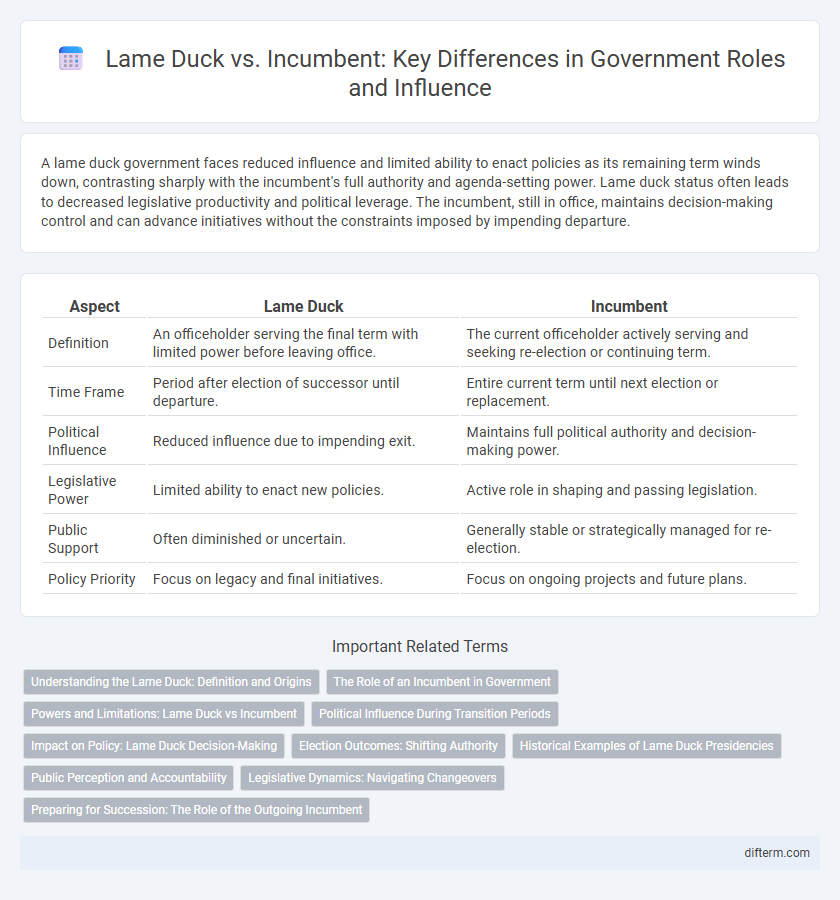A lame duck government faces reduced influence and limited ability to enact policies as its remaining term winds down, contrasting sharply with the incumbent's full authority and agenda-setting power. Lame duck status often leads to decreased legislative productivity and political leverage. The incumbent, still in office, maintains decision-making control and can advance initiatives without the constraints imposed by impending departure.
Table of Comparison
| Aspect | Lame Duck | Incumbent |
|---|---|---|
| Definition | An officeholder serving the final term with limited power before leaving office. | The current officeholder actively serving and seeking re-election or continuing term. |
| Time Frame | Period after election of successor until departure. | Entire current term until next election or replacement. |
| Political Influence | Reduced influence due to impending exit. | Maintains full political authority and decision-making power. |
| Legislative Power | Limited ability to enact new policies. | Active role in shaping and passing legislation. |
| Public Support | Often diminished or uncertain. | Generally stable or strategically managed for re-election. |
| Policy Priority | Focus on legacy and final initiatives. | Focus on ongoing projects and future plans. |
Understanding the Lame Duck: Definition and Origins
The term "lame duck" refers to an elected official whose successor has been elected but who still holds office during the transitional period before the new term begins. This phase typically occurs after elections, when the incumbent's power and influence are diminished due to their impending departure, impacting legislative effectiveness and decision-making. The origin of the phrase dates back to 18th-century London financial markets, describing investors unable to meet obligations, later adapted to politics to denote weakened officeholders.
The Role of an Incumbent in Government
An incumbent in government holds the current office and wields significant authority to influence policy, legislative agendas, and administrative decisions. Their position provides strategic advantages during elections, including access to resources, established political networks, and high public visibility. This contrasts with lame duck officials, whose diminished influence limits their ability to enact new initiatives or impact governance effectively.
Powers and Limitations: Lame Duck vs Incumbent
An incumbent wields full executive powers, leveraging established authority and ongoing policy initiatives, while a lame duck faces significant limitations due to diminished political influence and reduced legislative support. The lame duck period restricts the ability to enact substantial changes or push controversial agendas, as lawmakers often shift focus to incoming leadership. Consequently, incumbents maintain strategic control over governance, whereas lame ducks experience constrained effectiveness and transitional uncertainty.
Political Influence During Transition Periods
Lame duck officials face diminished political influence due to their limited ability to enact new policies, often resulting in stalled legislative agendas and reduced negotiations with incoming administrations. Incumbents retain significant control over government operations and can leverage executive powers to influence policy implementation during transition periods. The balance of power during these times shapes the effectiveness of governance and the continuity of political agendas.
Impact on Policy: Lame Duck Decision-Making
Lame duck periods often reduce the policy influence of outgoing officials, as their limited time in office weakens their leverage with lawmakers and stakeholders. Incumbents retaining full authority typically maintain stronger bargaining power to advance their legislative agendas and shape policy outcomes. Consequently, lame duck decision-making tends to slow policy progress and prioritize short-term or symbolic actions over substantial reforms.
Election Outcomes: Shifting Authority
Lame duck officials experience diminished political influence during the transition period following an election but before the new administration assumes office, often resulting in stalled legislative agendas and weakened policy enforcement. Incumbents seeking reelection maintain authoritative power while campaigning, leveraging existing office resources to influence voter sentiment and legislative outcomes. Election outcomes decisively shift authority from incumbents to successors, impacting government continuity, policy implementation, and administrative priorities during the transition phase.
Historical Examples of Lame Duck Presidencies
Lame duck presidencies often experience diminished influence and legislative success, as seen in the administration of President James Buchanan during the pre-Civil War era, where his inability to prevent secession marked a critical failure. Similarly, President Barack Obama's final term faced challenges in advancing policy agendas due to reduced political capital and opposition from a Republican-controlled Congress. These historical instances highlight the impact of diminished authority on governance during transitional periods.
Public Perception and Accountability
Public perception of incumbents often hinges on their ongoing policy decisions and responsiveness, maintaining direct accountability during their term. In contrast, lame duck officials experience diminished public influence and scrutiny, as their remaining tenure limits political leverage and perceived obligation to constituents. This shift impacts voter trust and expectations, altering the dynamics of governance and electoral accountability.
Legislative Dynamics: Navigating Changeovers
Legislative dynamics during lame duck periods often shift as outgoing incumbents lose influence, creating opportunities for new policymakers to assert priorities. Incumbents in transition may struggle to pass significant legislation, while incoming members leverage momentum to shape agendas and committee assignments. This interplay influences policy outcomes and strategic negotiations within government institutions during changeovers.
Preparing for Succession: The Role of the Outgoing Incumbent
The outgoing incumbent plays a crucial role in preparing for succession by ensuring a smooth transition of power through comprehensive knowledge transfer and maintaining stability within government operations. Effective collaboration between the lame duck official and incoming leadership minimizes disruption and preserves institutional continuity. Strategic planning and open communication during this period are essential to uphold public confidence and support governance objectives.
Lame Duck vs Incumbent Infographic

 difterm.com
difterm.com